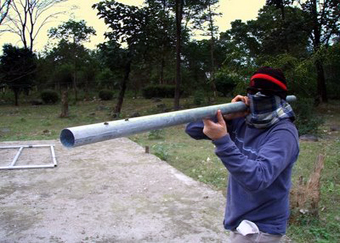
Motivations and Methods of India’s United Liberation Front of Asom (ULFA)
Publication: Terrorism Monitor Volume: 7 Issue: 9
By:

The United Liberation Front of Asom (ULFA) has been terrorizing India’s northeastern states since a student-led insurgency began thirty years ago on April 7, 1979. The movement’s primary goal is to achieve a sovereign homeland for the Assamese people. After three decades of political violence, the ULFA shows few signs of abandoning its struggle for an independent Assam, as demonstrated by a recent pre-election bombing in Guwahati, the state’s commercial capital (Hindustan Times, April 1). The blast occurred before India’s Minister for External Affairs, Pranab Mukherjee, was due to address a campaign rally on behalf of his ruling Congress Party.
The northeast Indian states known as the “Seven Sisters” are an ethno-linguistic archipelago of seething and unresolved conflicts with the central government in Delhi. Assam is the bridgehead both for the northeast region’s economy and the Indian security forces counterintelligence operations. ULFA represents the biggest indigenous strategic threat to the “Chicken’s Neck,” the vulnerable 20 to 40 km wide corridor sandwiched between southeastern Nepal and northwestern Bangladesh that connects West Bengal to Assam. Decades of ULFA insurgency and terrorism have led to the permanent presence of the Indian military (though nothing on the scale of Delhi’s forces in Jammu & Kashmir). Thirty years of political violence has been an obstruction to the development of this vital yet impoverished region. Assam is essential for the development of India’s crumbling domestic infrastructure and markedly growing economy. Upper Assam state’s carbon-based energy resource sector was developed under British rule and bequeathed to the Nehru government at independence. After nationalization via Nehru’s socialist inspired policies, it has continued to supply petroleum and coal to the Indian “mainland,” while many Assamese who inhabit villages adjacent to petroleum production in Digboi that open pit coal mining in Margherita cook dinner with firewood and eat by candlelight.
Droves of workers from India’s Hindi belt have migrated to Assam to cultivate its sprawling tea plantations and chip away at its mines. These mass migrations were encouraged during the British Raj when colonial officials needed vast numbers of laborers to fill the imperial treasuries and have continued unabated to the present day. Thus, the ULFA’s primary targets consist of both national and local political elites, the security forces and the Hindi-speaking migrant laborers (primarily from the poverty-stricken eastern Indian state of Bihar). A dominant factor in ULFA’s raison d’etre is an anti-migration sentiment mixed with linguistic chauvinism toward outsiders. The UFLA’s xenophobic doctrine insists that the influx of illiterate migrants into the state’s labor pool drowns out indigenous Assamese culture and leaves locals out of participating in their own rightful industries.
Critics in the Indian security establishment point to inconsistencies in the group’s rationale; the ULFA is vehemently against internal economic migration from within India but remains relatively silent on the illegal immigration of Bengali-speaking Muslims from Bangladesh (Rediff January 9, 2007). This contradiction is regarded by Indian officials as de facto evidence of the involvement of Bangladesh’s Directorate General of Forces Intelligence (DGFI), which Delhi believes to be supported by Pakistan’s Inter-Services Intelligence (ISI) (Rediff.com, January 17, 2007).
Though links to regional Islamist groups are often ascribed to unnamed government officials in Delhi or the Assamese state capital of Dispur the ULFA differs from the many militant Islamist groups operating on the sub-continent by being Hindu in origin and militantly ethno-nationalist in nature, not unlike the Liberation Tigers of Tamil Eelam in Sri Lanka (Times of India, October 21, 2004). Any coordination between the ULFA and religiously motivated non-state actors in Bangladesh and Pakistan would be of an operational nature based on temporarily dovetailing interests rather than any ideological commonality. Delhi seeks to emphasize the ULFA’s Islamist/terrorist connections through the national press, though publicly it presents scant empirical evidence to make such a case (Economic Times [New Delhi], February 7). Indian authorities and the Indian press seek to link the group to ISI-sponsored Islamist groups in Bangladesh and directly to the ISI itself.
The ULFA’s theater of operations and training is or has been comprised of the Buddhist kingdom of Bhutan, the predominantly Muslim hereditary democracy of Bangladesh, the Orwellian state of Myanmar and Nagaland, home of a predominantly Baptist revolutionary movement. The ULFA fights and terrorizes within an astonishingly Balkanized belt of ethnic and religious diversity. ULFA activities are rarely reported in the Western press unless they produce a mass casualty attack, such as the January, 2007 incident in which approximately 70 Bihari civilians were killed in a multi-day orgy of violence (Bloomberg, January 8, 2007). These attacks are partly aimed at disrupting the Assamese and Indian economy. Often when Bihari civilians are attacked they flee Assam en masse, leaving the state devoid of much needed labor.
Looking Eastward
Following the assassination of Rajiv Gandhi by a teenage Sri Lankan Tamil suicide bomber in 1991, India moved from an idealistic Nehruvian foreign policy into an era of realpolitik under the leadership of P.V. Narasimha Rao. India’s traditional support for democracy in Burma and its vanguard, Daw Aung San Suu Kyi, was put on the back burner in favor of creating trade relations with the Association of Southeast Asian Nations (ASEAN). Several of India’s northeastern insurgent movements maintained bases in the jungles of northern Myanmar, including the ULFA and the bitterly split factions of the National Socialist Council of Nagaland. The ULFA insurgency in northeast India stands in the way of India rebuilding the historic Stillwell Road that connects the region to China’s Yunnan province via Myanmar (Times of India, April, 11 2005).
A Roadblock to Regional Integration
Suppressing insurgency in Assam is an essential element of India’s “Look East” policy, as Delhi seeks to enhance trade linkages and military cooperation in Southeast Asia. If Assam is the gateway to India’s turbulent northeast, than Myanmar is India’s gateway onward to Southeast Asia. After the ULFA was largely expelled from its Bhutanese camps by the kingdom’s security forces in the 2003 Indian-assisted “Operation All Clear,” the Indian government has since sought to encourage the Burmese junta of General Than Shwe to expel ULFA rebels from its territory (which would leave Bangladesh as ULFA’s last external training center) in exchange for closer military-military and commercial ties (Times of India, December 30, 2003). The armies of Myanmar and India staged the “India-Myanmar Friendship Rally” in 2006 under the guise of memorializing the collective loss of Allied indigenous soldiers in WWII.
The impetus for India engaging Myanmar is twofold. Primarily, India is uneasy with Chinese expansion into Myanmar as China seeks out resources and blue water ports to meet rapidly increasing domestic consumption demands and strengthen its influence in the broader Southeast Asian/Indian Ocean realm. Secondly, India is seeking to exploit natural gas fields and other resources, along with China and South Korea, off western Myanmar’s Arakan coast (Asia Times, April 3). Creating pipelines, reviving WWII colonial era roads and turning a blind eye to human rights are factors in India’s new relations with the Than Shwe government. The ULFA and its goal of Assamese secession is a nagging impediment to Delhi’s belated plans for development of the Northeast necessary for integration with ASEAN.
Methods of Terror
ULFA guerrillas, who are routinely referred to in the Indian press as “cadres” or “ultras,” routinely extort money from sprawling tea estates that blanket Upper Assam and target estate officials for kidnapping and assassination (The Telegraph [Kolkata] November 30, 2008). Tea estate workers in Upper Assam interviewed by the author described night visits by ULFA insurgents demanding cash, food and silence on the group’s movements in exchange for remaining unharmed. The workers, primarily Bihari peasants, said that while the Indian Army controls the roads in Tinsukia district during the day, the ULFA operates freely at night. ULFA members occasionally slaughter groups of Biharis to demonstrate the reality of their threats.
In Assam’s urban centers, ULFA members commonly plant explosive devices on motorcycles and bicycles, hurl grenades into unsuspecting marketplaces and place bombs in rubbish bins to make their point (Telegraph, March 26, 2008). The ULFA also instructs whole commercial districts to commence bandhs, or strikes, where guerillas force commerce to come to a halt under threat of violence. Shop owners seen conducting business during a bandh may be killed or have their enterprises destroyed for disobeying an ULFA ultimatum. By issuing bandh diktats, ULFA leaders seek to send a message of immense dissatisfaction to Delhi and punish local leadership in Dispur for its perceived intransigence.
Though the Indian government has had a certain degree of success with getting particular factions of northeastern insurgent groups to demilitarize and surrender, there always seems to be hardcore elements within these fissiparous, personality-driven movements that are irreconcilable to anything less than their stated aims. The “Charlie” and “Alpha” companies of the ULFA’s 28th Battalion, allegedly based in Myanmar, have ceremonially surrendered and agreed to ceasefires while other irreconcilable elements within the movement have yet to come in from the cold (The Hindu, June, 25 2008).
Conclusion
At the thirtieth anniversary of ULFA’s founding, the group and its activities in Assam show few signs of genuinely abating despite pronouncements by Indian authorities to the contrary. The ULFA’s military leader, Paresh Barua, also appears no closer to being apprehended in his sanctuary in neighboring Bangladesh, though negotiations on the ULFA issue are under way following the election of the pro-India Awami League government in Dhaka. As the Indian military’s primary focus will likely remain along its western frontier with Pakistan and maintaining one of the world’s largest military occupations (and subsequent counterintelligence operations) in Jammu & Kashmir, it will be very difficult for Delhi to dismantle the ULFA in the long term. The ULFA has suffered military and logistical setbacks in recent years but not nearly enough to bring the organization to an end. The grievances that have fostered the Assamese insurgency, primarily allocation of resources, unfettered migration from the Hindi-speaking belt and prospects for Assamese independence, are unlikely to be addressed by the central government. With India and China in competition throughout this complex region while still retaining a degree of distrust stemming from unresolved territorial disputes in the aftermath of the 1962 Sino-Indian war, prospects for a comprehensive regional peace process are highly unlikely. Economic interdependence between Asian powers is moving ahead faster than the resolution of long standing ethno-nationalist grievances (with their suspected foreign sponsors) and trade may ultimately trump diplomacy in this bitterly contested region.





